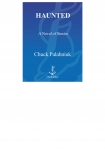Haunted, Chuck Palahniuk [urban books to read TXT] 📗

- Author: Chuck Palahniuk
Book online «Haunted, Chuck Palahniuk [urban books to read TXT] 📗». Author Chuck Palahniuk
The other residents, one girl has green eyes. A guy has brown eyes. With the container suits on, all you can see is somebody's eyes. The boy with the brown eyes, Shirlee says he's the other Type 1 Keegan carrier.
The new guy with the huge dick. She's seen it through his two-way mirror.
Shirlee says, next time I talk to Dr. Schumacher, I should ask about starting a breeding program. To see if we can give birth to a generation of babies immune to Type 1 Keegan. Another scary possibility is, this boy and me, we have different strains of the virus, and we'd just kill each other.
Or we'd have a healthy baby . . . and we'd kill it with our germs.
“Slow down,” Shirlee says. “Forget babies. Forget dying.” She says what's important is getting me deflowered.
This boy and me, the two of us locked up in a room, together. Both of us virgins. The video camera behind the mirror, watching, the staff hoping we'll breed a cure the government can patent. Those crafty drug-company people. Still, a cure wouldn't be bad.
And sex, that wouldn't be bad, either.
Shirlee says sometime The Orphanage should have a dance for the residents, but just the image of those baggy blue container suits, clutching each other and swaying to some pop music on a dance floor . . . nobody wants to see that.
Most times when I see Dr. Schumacher, I don't tell the doctor jack shit. The way I figure, I only have so many memories, and I don't want to use them up. Most of my best memories are of saving the world from evil space aliens or escaping on a jet boat from sexy Russian spies, but those aren't real memories. Those were movies. I forget how the girl doing that is a movie star.
Framed on the wall in my room, a sign says: Busy = Happy.
Shirlee says this same sign is in every resident's room. The lightbulbs in each room are full-spectrum lightbulbs that simulate natural sunlight, generating vitamin D in people's skin and keeping their mood up. Shirlee says the official term for each room is “resident suite.” Mine, for example, is “Resident Suite 6-B.” On all my charts and records, officially, I'm known as Resident 6-B.
As a parallel study, Shirlee says the data collected on residents here will be used to predict how people might live better in isolated, self-contained outer-space colonies.
Yeah, some days, Shirlee is full of useful information.
“Think of yourself,” Shirlee says, “as an astronaut living in a Ramada Inn on a planet only six miles southwest of Seattle.”
Shirlee, her voice coming over the intercom at night, she'll ask about my dad, how did my father get me put here. Then Shirlee will let go the button on her side, waiting for me to speak.
My old man, he didn't know enough for a college degree, but he knew how to make money. He knew guys who'd wait until the day you left on a week's vacation, then they'd move in with a crew and cut down a two-hundred-year-old black-walnut tree. They'd limb it and section it, right there in your front yard. They'd tell the neighbors you'd hired the work done. By the time you got home, your tree would be cut and milled and curing in some factory a dozen states away. By then it might even be black-walnut furniture.
This is the kind of smarts that scares the crap out of college people.
My old man, he had his maps. His treasure maps, he called them.
These treasure maps, they were from the 1930s, from the Great Depression. What people called the Works Project Administration, the government hired folks to go around and take notes about every abandoned cemetery in every county. Every state. Back when lots of these little cemeteries were going under the plow or about to be forgotten under blacktop. These old pioneer cemeteries, they were all that was left of towns that had disappeared from maps a hundred years before. Boom towns now crumbled and blown away. Or burned to ashes by forest fires. Gold mines that played out. Railroad spurs that shut down. All's that would be left is the little cemetery, a patch of weeds and fallen-down old headstones. The old man's treasure maps were the WPA maps, showing where to find each patch, how many graves it held, how the headstones would look.
Every summer I was out of school, me and the old man would follow these maps up into Wyoming or Montana, into the desert or the hills, where whole towns had vanished. Towns like New Keegan, Montana, where nothing's left except the tombstones. It was the kind of stuff that garden stores paid big money for in the city. In Seattle or Denver. San Francisco or Los Angeles. A load of hand-carved granite angels. Or sleeping dogs or little white marble lambs. People wanted something old and crusted with moss to put in their brand-new garden, to make their place look ancient. To look like they'd always had tons of money.
In New Keegan, not one of the tombstones had writing you could still read.
“Shaving cream,” my Dad told me. “Shaving cream or chalk. Goddamn fucking graveyard freaks.”
He told how people who loved to study tombstones, to read a faint inscription worn away by time and acid rain, they'd wipe shaving cream across the face of the tombstone. They'd shave off the extra with a piece of cardboard, leaving just the white in the engraving. This made the words and dates easy to read and photograph. What sucked is, shaving cream contains stearic acid. The residue these people left would eat the stone.





Comments (0)